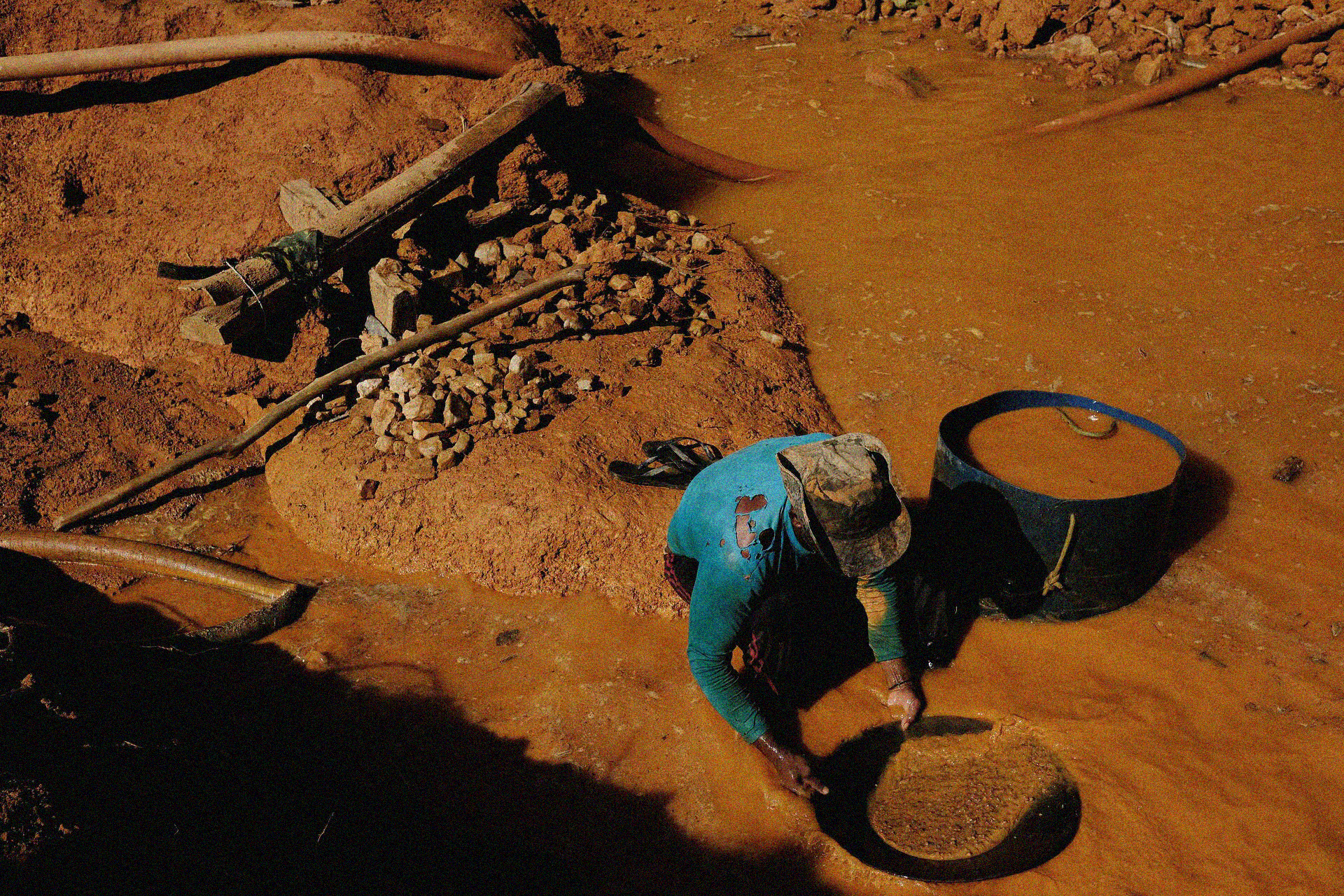
Illegal mining has brought devastating consequences to the indigenous Yanomami people, leading to a severe humanitarian crisis.
Scroll down to understand what’s happening — and how you can help
Gold is Death
THE GOLD CRISIS
The illegal gold trade in Brazil is fueling the genocide of the Yanomami people and the destruction of the Amazon. Over 20,000 miners have invaded Yanomami lands, spreading mercury contamination, disease, and deforestation. Entire villages have been displaced, and mortality rates have soared. Despite its illegality, this gold is laundered through a loophole: Brazilian buyers can self-declare its origin, allowing forged documents to pass it off as legal. States like São Paulo and Minas Gerais, which produce little or no gold, serve as laundering hubs. Once “legalized,” the gold is exported—mainly to Canada, Switzerland, and the UK—under false legitimacy. This system enables environmental crime and Indigenous death. Without enforced traceability and accountability from importing countries, the blood gold trade will continue.
YANOMAMI GENOCIDE
The Yanomami people are facing a modern genocide driven by Brazil’s illegal gold trade. Over 20,000 illegal miners have invaded their federally protected territory, destroying forests, contaminating rivers with mercury, and bringing disease and violence. Entire villages have been displaced. Children are dying from malnutrition and poisoned water. Women suffer sexual abuse at the hands of miners. The Brazilian government has failed to enforce protections, and the gold extracted from this destruction flows untraceably into the global market.
This isn’t just environmental crime, it’s systemic annihilation. The gold that fuels this crisis ends up in luxury goods, stripped of its origin in Swiss and Canadian refineries. Every link in this chain, from the miner to the final buyer, is part of a brutal cycle that erases lives for profit. Unless traceability and accountability are enforced, the Yanomami genocide will continue, funded by silence, enabled by global demand, and polished into jewelry..
BLOOD GOLD FOR EXPORT
A large portion of Brazilian gold exported to rich countries is hard to trace and likely contaminated by illegality. In Brazil, the gold trade operates on a flawed system of self-declaration—meaning sellers can falsely claim legal origin without verification. This loophole enables gold illegally mined in the Amazon, often on Indigenous lands, to be laundered through states like São Paulo and Minas Gerais and exported as “legal.”
The lack of a traceability system turns this into a perfect crime: gold tied to deforestation, mercury poisoning, and Indigenous displacement ends up in luxury markets with no accountability.
TIn 2024, Brazil exported 111 tons of gold. An estimated 71% was illegal. These are the top 10 countries buying Brazilian gold that year, with their share of total exports
1. Canada. 36.8%
2. Switzerland. 17.9%
3. United Kingdom. 9.9%
4. India. 7.6%
5. United Arab Emirates. 6.1%
6. Italy. 5.3%
7. Hong Kong. 3.6%
8. Germany. 2.8%
9. United States. 2.1%
10. Belgium. 1.3%
These nations are key destinations for gold of dubious origin—and play a vital role in perpetuating or halting this destructive trade.
LUXURY AND DEATH
Luxury brands have no excuse. They operate in one of the world’s most profitable industries, yet most rely on vague certifications and look the other way when it comes to sourcing their gold. If a brand doesn’t demand full traceability, knowing exactly where its gold comes from, it is complicit and most likely coming direct from conflict zones. Complicit in environmental devastation. Complicit in the genocide of Indigenous peoples. Complicit in laundering criminal activity into luxury.
The truth is simple: brands that stay silent are protecting their supply chains. Their refusal to trace is a refusal to act. Gold should never come at the cost of human lives and ecological collapse. If brands want the prestige of gold, they must also bear the weight of responsibility that comes with it. Anything less isn’tluxury, it’s violence disguised as jewelry
Rolex
No public disclosure of gold origin. Refuses to engage with human rights inquiries. Zero traceability
Bulgari (LVMH Group)
Vague, generic sustainability statements. No mine-level gold traceability. Lacks verified third-party audits
Tissot (Swatch Group)
Provides no sourcing information. Scored poorly in WWF transparency rankings. No ethical gold policy
Harry Winston
No transparency or gold sourcing disclosure. Not RJC-certified. Ignores industry watchdog reports
Van Cleef & Arpels (LVMH Group)
No specific gold sourcing policies. No traceability initiatives. Fails to confirm responsible sourcing
Chopard
Claimed “ethical gold” without verifiable proof. No third-party traceability. Lack of consistent auditing
TAG Heuer
Minimal public sourcing information. Low score on transparency from NGOs. No evidence of gold supply chain verification
THE BRANDS REFUSING TO BE TRANSPARENT
WHAT TO DO
Demand transparency from luxury brands. They are complicit, if not responsible for the violence towards the Yanomami and the destruction of the Amazon. Without their money, there’s no illegal gold trade.
DON’T BUY FROM BRANDS WHO WON’T TELL WHERE THEIR GOLD COMES FROM.
In fact, email them and demand transparency and the complete halt of Brazilian gold buying.
Core Emails:
Chopard: info@chopard.com
Piaget: contact.piaget@piaget.com
Harry Winston: clientcare@harrywinston.com
Tiffany & Co: customerservice@tiffany.com
Cartier: contact.us@cartier.com
Bulgari: contactus@bulgari.com
Van Cleef & Arpels: client.relations@vancleefarpels.com
Rolex: info@rolex.com
Omega: info@omegawatches.com
IWC Schaffhausen: info@iwc.com







